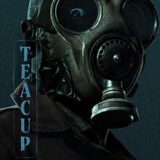As many of the readers may remember, the “New Weird” movement in the beginning of the millennium signified a new tendency in SF&F literature in the sense that more and more writers were now trying very hard to incorporate new ideas into their works. During the last decade, a number of the “New Weird” fictions have been translated into Chinese and published in mainland China. In January 2015, as the translator for China Mieville’s books The Scar and The City and The City, I offered a talk on New Weird and the works of China Mieville in Shanghai on a forum organized by AppleCore, a fandom based in Shanghai. (For more information about AppleCore, there is a blog entry by Regina Kanyu Wang on Amazing Stories web site.)
The event was held in a lecture room of Shanghai Library and attracted about 40 people, which was a quite comfortable number for a speech and the interactions afterwards. As one might expect, New Weird was not a well-known concept in China, even among the science fiction and fantasy readers. Most had not heard of it and for those few who had, it was not clear what the name represented. They might have read one or two books that fell into this category, but that was all.

So I began with the definition of New Weird, referencing the anthology The New Weird, Edited by Jeff VanderMeer and Ann VanderMeer, followed by some arguments regarding whether New Weird really exists and the origins of New Weird. Then I moved on to the works of China Mieville, going through his novels, introducing the stories as well as their settings, backgrounds and what had made each of them successful. It was quite a comprehensive session since I covered all the published novels by China Mieville. My presentation concluded with a brief catalogue of other New Weird authors, such as Jeff VanderMeer, K.J. Bishop and Steph Swainston.
The next part was another speech given by a member of AppleCore, Gong Li, who had made a little research into the origins and development of New Weird. The contents were organized in a way that could inspire the audience to participate in the discussion. For example, he had asked questions like why New Weird is considered new, and how New Weird is perceived as weird. Then, near the end of his speech, he listed out some other works that shared similar traits with New Weird, in both literature and other media, such as graphic novels, movies and computer games.

The audience was responding very actively to the questions and although there were no rights and wrongs to the answers, the discussion did help the readers to develop deeper thoughts on what New Weird stood for and what was the significance of it despite the controversies and the lack of a greater popularity. It was also observed that in order to get a better grasp of unfamiliar ideas, readers tended to connect them to those they were already familiar with. For instance, Black Mirror and X-Files were mentioned during the discussion by the audience, in the attempt to summarize the characteristics of New Weird. Moreover, comparisons were made between Japanese weird stories and New Weird since there had been quite a number of Japanese speculative fictions translated into Chinese over the years.

One week after the forum, AppleCore organized a reading session for The City and The City, during which, about 10 readers shared their thoughts on this award winning book by China Mieville. I was invited to the session as well. Here are some quotes from our readers.
——This is a book of mixed genre. You can think of it as science fiction for the study of cognitive ideology it implies, or as fantasy for the unique and ingenious world building, or as Mystery, which it actually is.
——The imaginary boundary between the two cities is dynamic and indistinct, which allows a new form of strangeness that cannot be found in everyday life, or in any other speculative fictions, for that matter.
——The promotional materials of the book mention Kafka and Orwell, which implies dystopian themes. However, there are no distinctive dystopia elements in the story. Despite the existence of Breach, the separation of the two cities is imposed on the residents by themselves. There is no compelling motivation to lift the taboo of breach.
——The book starts with a slow pace. It is at the end of the first chapter, with the descriptions of the old woman in the street, that the weirdness of the settings begins to show. Afterwards, the political elements were revealed gradually while the story pushes on. However, it has not become a political novel by the end of the book.
——This book reminds the reader of the two planets in Dispossessed, by Ursula Le Guin. But The City and The City is closer to real life, with rules and regulations that are incorporated into the real world.
——In the book, there are some interesting narratives that would invoke vivid images in the mind’s eye of the reader, for example, the sardonic manner of the Beszel police chief when talking to the protagonist. That kind of narratives insinuates a touch of dark humor into this detective story.
After the forum and the reading session, it did not surprise me to see that Chinese readers would soak up the fresh ideas from western SF&F books as easy as readers in any other countries. They have the same learning curve and the same mind set as others to conceive the unfamiliar strangeness of New Weird. The only barrier is language. So, dear authors, the message is clear. If you have a story that clicks, get it translated and published in China, and wait for the spell to take its toll.











I’m chatting with a friend of mine in Beijing about language. I described the plot of Mieville’s ‘Embassytown’ and he asked if there were a Chinese translation. Do you know if there has been one?